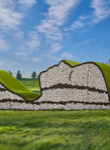- Family (English) Iris
- Family (botanic) Iridaceae
- Tree or plant type Perennial
- Native locale Non-native
- Size range Large plant (more than 24 inches)
- Light exposure Full sun (6 hrs direct light daily), Partial sun / shade (4-6 hrs light daily)
- Hardiness zones Zone 4, Zone 5 (Northern Illinois), Zone 6 (City of Chicago), Zone 7, Zone 8, Zone 9
- Soil preference Acid soil, Wet soil
- Tolerances Occasional flooding, Road salt, Wet sites
- Season of interest early summer, midsummer
- Flower color and fragrance Purple
- Shape or form Narrow, Upright
- Growth rate Moderate
- Wildlife Butterflies, Hummingbirds, Insect pollinators
-
More information
Russian iris prefers moist to wet soils in full sun. From early summer to midsummer, the plant produces large flowers in a variety of colors that rise above the long, arching leaves. This is a species that can be grown in a rain garden, cut-flower garden, beds, borders, or near ponds and streams.
Size and method of spreading:
Russian iris is between 2 to 4 feet tall and 1 ½ to 2 feet wide. It primarily spreads by producing offsets from underground stem structures (rhizomes) but may also self-seed.
Native geographic location and habitat: (include C-value if appropriate)
Russian iris is native to Eastern and Northern Asia, including Siberia.
Attracts birds or pollinators:
Russian iris attracts hummingbirds, butterflies, moths, and bees.
Leaf description:
The leaves of Russian iris are up to 2 feet long and swordlike (lanceolate to linear). They are a medium yellow-green, but variegated cultivars are available. The leaves may stand erect or arch. The bases of the leaves wrap around the stems (sheaths).
Flower description:
Russian iris flowers are a bit flatter than the flowers of other species of iris and cultivars are available in a variety of colors. The flowers are between 3 to 6 inches in diameter and occur singularly or in small groups at the terminal end of stalks that can grow up to 4 feet long. They typically have three rounded, ruffled, spreading petal-like sepals, or falls. These falls surround the bases of three smaller petals, or standards. Emerging from the center of the standards are three petal-like structures (divided petaloid style) that hide the pollen-bearing structures (stamens). Some cultivars are available in the form of single or double flowers that are produced in a variety of colors.
Fruit description:
The capsules produced by Russian iris are up to 1 inch long, dry, and split into three sections at the top when mature.
Plant Care:
Wear gloves when handling to avoid skin irritation. In wet conditions, planting Russian iris in pots that can be removed for winter is recommended to prevent issues with root rot. They can tolerate partial shade but will flower best in full sun. During the growing season, Russian iris requires supplemental water in average garden soils. Removing spent flower stems can reduce self-seeding. This species may require division.
List of pests, diseases, and tolerances:
In wet winter conditions, Russian iris may suffer from issues with root rot. Thrips can be a minor issue for this species.


























































































